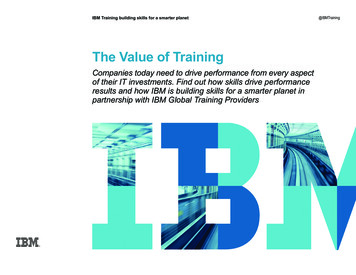
Transcription
IBM Training building skills for a smarter planetThe Value of TrainingCompanies today need to drive performance from every aspectof their IT investments. Find out how skills drive performanceresults and how IBM is building skills for a smarter planet inpartnership with IBM Global Training Providers@IBMTraining
IBM Training building skills for a smarter planetThe Value of TrainingIntroductionTop performing companies not only recognize theimportance of their people but also the need toprovide the right skills to enable their people. 71%of CEOs cited human capital, ahead of products,customer relationships and brands as the leadingsource of sustained economic value. In additionCEOs ranked “People Skills” in top 4 “Externalforces impacting the enterprise”. 84% of employeesin Best Performing Organizations are receiving thetraining they need compared with 16% in the worstperforming companies.Source: “IBM Smarter Workforce (Kenexa) 2013 SurveyToday more than ever, companies need to maximizetheir human capital by providing the right skills at theright time for the right people. Embracing the rightlevel of IT training, enablement and engagementcan dramatically reduce attrition and safeguard theinvestment made in hiring.Employees who do not feel they can achieve theircareer goals at their current organization are 12 timesmore likely to consider leaving than employeeswho do feel they can achieve their career goals. Evenworse, this number skyrockets to about 30 timesmore likely for new employees. Considering theamount companies invest in the recruitment processand the time lost to filling the same role again, theimpact to performance and margin can be significant.In this document, we will point to market driversand perform a reality check in the skills someorganizations have and the market readiness to fillthe current and future skills gaps. We show researchwhere more than 65% of global leaders cite “talentand leadership shortages” as their #1 businesschallenge and with some skill areas, a full 90% oforganizations do not have all the skills they needto be successful. We will look at the recommendedaction that companies can take to drive the right skillsand look at how to link training to the business goals.We will review the benefits of a skilled workforce andtechniques to help you measure the ROI of training.This paper outlines the gains your organizationcan achieve in client success, project success andadoption, product development, sales, risk management and retention and how you can measure thereturn on investment from a well designed skillsbuilding program that links your solution to yourbusiness needs.2
IBM Training building skills for a smarter planetThe Value of TrainingTable of ContentsIntroduction2Table of Contents3People and Skills:What OrganizationsSenior Management Think4The ROI of Trainingwithin your Organization6Today’s organizations facenew problems11Recommended action:Build skills internally14IBM Training: The New Model173
IBM Training building skills for a smarter planetThe Value of TrainingPeople and Skills:What OrganizationsSenior Management ThinkToday, companies need to do everything possibleto drive performance; people and skills are a strategicpart of this performance. The IBM C-suite Studyis a result of analyzing our conversations with4,183 leaders in 70 countries. We spoke with across-section of C-suite executives in more than20 industries: This study offers insight into howthese leaders view the world, their priorities and howthey are preparing for the future. In the study, CEOsrank People Skills in the Top 4 external factors thatwill impact their business in the next 3 to 4 years.71% Of CEOs identifiedhuman capital as a key source ofsustained economic valueSource: “Leading through Connections” IBM CEO Study, 2012In fact from 2004 through 2013 across all of theC-Level, people skills rank high on the list ofexternal factors that will impact performance.People Skills Top 4 FocusCEOs Rank People Skills intop 4 “External forces impactingthe enterprise”The senior management inside organizations hasa clear idea that skills matter. In the next section welook at the Return On Investment (ROI) for Training.Perceptions of new employee training byjob levelIt is clear senior management teams at successfulclients recognize the need for skills and training.There is a disconnect however between what thesenior management believe is being delivered andwhat is actually being delivered.Perceptions of new employee training by job levelSource: IBM C-Suite Survey 2013In the prior year, 71% of CEOs cited human capital,ahead of products, customer relationships and brandsas the leading source of sustained economic value.Source: IBM Smarter Workforce 2013 Training and Tenure ReportSource: Question E8–What are the most important external forcesthat will impact the enterprise over the next 3 to 5 years?; n 4,0094
IBM Training building skills for a smarter planetThe Value of TrainingPerceptions of new employee training by HR roleor departmentFor example, an introductory sales course couldbe evaluated by giving students a survey aboutthe training quality (reaction), by testing studentson the content taught in the sales course (learning),by observing whether students actually end upusing the sales tactics they learned (behavior), or bymeasuring changes in sales volume before and aftertraining (results). By evaluating training effectivenessand sharing those results across the company,organizations can close the gap between perceptionsof managers, HR professionals and the rank-and-file.Source: IBM Smarter Workforce 2013 Training and Tenure ReportDecision-makers — senior leaders and HR professionals seem to be a little more optimistic. Seven out of10 HR professionals believe employees are gettingthe training they need and that figure rises to eightout of 10 among senior leaders. Clearly a disconnectexists between decision-makers and trainingrecipients, perhaps resulting in under-investmentin training in many organizations.One solution for this disconnect may be a lackof objective training performance metrics. Accordingto Dr. Donald Kirkpatrick, Professor Emeritus atUniversity of Wisconsin and Honorary Chairmanof Kirkpatrick Partners, there are four ways to evaluatetraining: reaction, learning, behavior and results.Working with the management team to bridge the gapThe Authorized IBM Global Training Providers have theability to work with IBM Clients to address all the needsof the senior management team and client HR teams. Linking training to business needsOne stop shop — our IBM Global Training Providersare not limited to just IBM Training, offering otherIT technology training, project management andother related trainingSkills gap analysisDriving training effectiveness metrics and performanceHosting Learning Management Systems and integrationinto existing5
IBM Training building skills for a smarter planetThe Value of TrainingThe ROI of Trainingwithin your OrganizationBest performing companies investin trainingIn a recent IBM Smarter Workforce study IBMlooked at best performing companies and worstperforming companies to see if skills had a part toplay in performance. The results we found are notsurprising: 84% of employees in Best PerformingOrganizations are receiving the training they need,a full 68% better than worst performing companies.Relationship between number of hoursof training and project success.Relationship between team skill andstakeholder objectivesRelationship between number of hours of trainingand project success.Relationship between team skills andstakeholder objectivesThe amount of training does not need to be massive.When preparing for a project, teams receiving40 hours of training per member met their significantproject objectives three times as often as teamsthat received 30 hours of training or less.iTraining helps stakeholders win: Objectiveswill be met 90% more often by increasing teamskills. Increasing team skills by 1/3 increaseslikelihood of stakeholders meeting their objectivesfrom 10% to 100%.iiSource: IBM Smarter Workforce 2013 Training and Tenure ReportSource: IDC’s Training Impact on Projects Survey, 20116
IBM Training building skills for a smarter planetThe Value of TrainingBenefits of a skilled workforceThe benefits of a skilled workforce and a learningsolution are significant and measurable, and theyaffect all areas of the organization from sales andmarketing to customer service and support.They include: 16% increase in customer satisfaction amongcompanies using learning technologyiiiSkill levels linked to business value, 70,000 inannual savings and 10% increase in productivitywhen teams are well trainediv35% reduction in time spent searching forsales contentv22% faster rollouts of products and processes75-80% of managers believe effective trainingis critical to project success and meetingproject deadlinesviiBuilding skills for a smarter workforceIt pays to work smarter not harder. Accordingto a 2010 study by the IBM Institute for BusinessValue, organizations that are significantly outperforming their industry peers also happen to bemaking more headway on newer approaches towork. They are using dynamic, collaborative andconnected ways of working to get things doneeffectively within a constantly changing environment.How can organizations work smarter? ThroughIBM’s interactions with clients around the world,we have witnessed a number of practices that aremaking organizations more agile. These approachesto how work gets done fall into three main categorieswhich make their organizations more: “75-80% of managers believeeffective training is critical to projectsuccess, skill levels linked tobusiness value yield a 10% increasein productivity” Dynamic — adjusting rapidly to changingbusiness conditionsCollaborative — bringing together resources,both internal and external, to share insights andsolve problemsConnected — enabling access to informationregardless of time, distance or organizational silosSmarter working practices provide organizationswith greater agility.Source: “IBM Institute for Business Value — A New Way orWorking” 2010.The IBM Institute for Business Value (IBV)research revealed several interesting findings: Outperformers use smarter working practices farmore extensively than their lower-performing peersand they are doing so to fuel growth, not justdrive efficiency.For most organizations, the ability to adapt toa constantly changing environment is hamperedby capability gaps in three primary areas: processand skill reconfiguration; broader and moreembedded collaboration and integrated, real-timeinformation for decision-making.The most dynamic, collaborative and connectedcompanies have widely adopted certain technologies that make smarter working practices viable.7
IBM Training building skills for a smarter planetThe Value of TrainingWorking together with an IBM Global TrainingProvider, IBM Clients gain access to skills mapsdeveloped for roles and solution areas, a dedicatedclient team that will work with the client to identifyany potential skills gaps and a dynamic plan toaddress these gaps.The skills gap is not just about technical ability anddriving process efficiencies, nor is it just aboutengaging employees to make them more productiveand to reduce attrition costs. Companies who aresignificantly outperforming within their industries arealready positioning for growth. They are far lessworried about operational efficiency, perhapsbecause they have already addressed the skillsgap to outperform in these areas. Instead, they areconcentrating on innovation and expansion. Theirfocus revolves around introducing new (and adaptingexisting) products and services and addressingregulatory requirements, which also relates to theirexpansion into new geographies and markets.Outperformers are already positioning for growth today.Extensive adopters of smarter working practices*Source: “Study by the IBM Institute for Business Value – A New Wayor Working”IBM Training and our IBM Global Training Providersunderstand the need to leverage the client’ssolution combined with the talent of the organization,linking this to the business needs and smarterworking practices.Compared to other companies, outperformers aremore than three times as likely to have adoptedsmarter working practices.Source: “Study by the IBM Institute for Business Value — A New Wayor Working” 2010.Where outperformers leadOutperformers are developing capabilities thatallow them to adjust and react more rapidly.Compared to their less adaptable peers, more thantwice as many outperformers can: Easily identify individuals with needed skillsDisplay and deliver information to meet theneeds of various audiencesQuickly build skills to address changing conditions8
IBM Training building skills for a smarter planetThe Value of TrainingOur IBM Global Training Providers offer traditionalofferings of public and private training but this issignificantly augmented by “Smarter Skills Services”such as: Skill Gap AnalysisBusiness Transformational ServicesContent Customization to make the learning fitCollaborative and Connected Learning Sessionsand toolsLearning CoachingBoot Camps and Re-Skilling SessionsEnterprise Learning Licensees — where clientsthat have invested in their own competencycenters can leverage IBM and IBM GlobalTraining Provider Content with a right to useor right to modify licenseThey are also offering many more dynamic servicesthat adapt to the business and learning needs oftoday. IBM and its Global Training Providers arealso establishing work methods that facilitate andencourage collaboration by leveraging the collectivestrengths of our customer’s organizations.Cost of losing your staff investmentOrganizations should consider the cost of recruitmentand attrition. Although this paper does not attemptto quantify the differing costs of recruitment withina client’s organizations, it is imperative to look atthe impact of training on new hire recruitment and theimpact of skills on career development and retention.New Employee Turnover Intentions by Training“New Employees are 42% morelikely to stay when receiving thetraining they need to do theirjob properly”Training and an investment in developing a skillsbuilding culture dramatically impacts employeeretention. Only 21% of new hires intend to stay atcompanies that do not offer training for their currentjobs. However, the study reveals that 62% of newhires intend to stay when training is provided. Thisnearly three-fold increase is a powerful example ofthe positive impact of training on new hire retention.Source: “Study by the IBM Institute for Business Value – A New Wayor Working” 2010.9
IBM Training building skills for a smarter planetThe Value of TrainingEmployees who do not feel they can achieve theircareer goals at their current organization are 12 timesmore likely to consider leaving than employees whodo feel they can achieve their career goals. Evenworse, this number skyrockets to about 30 times fornew employees.Turnover Intentions by Ability to Achieve Career Goalsby Organizational TenureThe importance of career development, especiallyto new employees, again highlights the importanceof having an onboarding process and learningmanagement system (LMS). While onboarding andlearning management have focused traditionally onjob training, IBM Global Training Providers can workwith clients to develop processes and systems to helpnew employees facilitate informal mentoring, fostercollaboration across jobs and business functions andidentify subject matter experts within the organization.In addition they can provide linkage to training inthe right modality to facilitate development, accessto IBM, third party and company repositories to sharetechnical knowledge.Source: IBM Smarter Workforce 2013 Training and Tenure ReportAn IBM Global Training Provider can work together withclients to create an always-learning paradigm that candrive solution success and address retaining the rightresources in your organization with the right tenure.10
IBM Training building skills for a smarter planetThe Value of TrainingToday’s organizations facenew problemsThe Dynamics of the Modern WorkforceThe dynamics of the modern workforce are makingit difficult for companies to find and keep talentedworkers. Here are some startling statistics: A full 90% of organizations do not have all theskills they need to be successfulviiiMore than 65% of global leaders cite “talent andleadership shortages” as their #1 businesschallengeixThe 74 million next-generation workforce of15- to 24-year-olds who are unemployed are notskilled to fill the skills gapxSource: IBM Tech Trends ReportKnowledge LeakKnowledge leak is another critical problem. How doyou keep the intellectual capital you have? Mostresearch on retention suggests nearly 30% lossof skill annually for skills that are not routinelyreinforced, though significantly less when skills areroutinely (and correctly) performed. The starting skillof an organization can range anywhere from nearly100% after extensive organizational training to aslittle as 50% or 60% after several years of littleinvestment in training and normal turnover in theIT environment.xiChanging dynamics in the workforce, whereemployees have little sense of loyalty for theiremployers, compounds the problem. Employeeswho do not feel they can achieve their career goalsat their current organization are 12 times morelikely to consider leaving than employees whodo feel they can achieve their career goals. Evenworse, this number skyrockets to about 30 times fornew employees.xiiPeople under the age of 35 are twice as likely tobe looking for new work as older workers. What’smore, the total costs of replacement can reach200% of an employee’s annual salary.xivGenerations of LearningWith the mix of generations within an organization,businesses must ensure that they are addressingthe learning styles that work for that generationfrom the traditionalist with public training to theMillennial who wants to have just-in- time trainingavailable on his/her mobile device.11
IBM Training building skills for a smarter planetThe Value of Training An IBM Global Training Provider is able to leverage thehigh quality, up-to-date Authorized IBM Content withsmart and connected delivery engines to address thelearning needs of today’s enterprise. Market Drivers Technology is changing everything: The “four pillars”of the 3rd Platform — mobile, cloud, social, andBig Data — are impacting current job roles anddriving demand for new roles and skills. Mobility is an important driver of enterpriseinnovation, requiring broader technical skill sets tosupport users in their day-to-day work and ensurethat a myriad of device and software combinationswork optimally. According to IBM’s Tech TrendsReport, 70 percent of respondents say they planto increase spending in mobile in the next twoyears. The shift toward BYOD is even morepronounced in growth markets like Brazil, Russia,India, China and South Africa, where 41 percent ofthose surveyed will allow employees to connecttheir own computing devices to their network within two years, bringing the total to 83 percent inthose countries.Cloud is both a delivery model and a consumptionmodel for IT, creating a shift in internal roles fromIT builders and managers to brokers, strategists andbusiness supporters.Social media, as a core part of IT’s next growthplatform, brings with it the problem of data privacy,driving demand for expertise in that area.Big Data comprises a set of genuinely newtechnologies and a convergence of more maturetechnologies. Organizations must be prepared toembrace a more information-led culture.These shifts in technology will redefine the roleswhich are important for an organization to succeedand require companies to hire or retrain employees.Community managers, mobile developers and BigData analysts will take on increasing importance asother roles, such as desktop application support,will decline.The world does not stand still, and neither have we.The technologies underpinning Smarter Planet —Big Data analytics (including IBM Watson), mobile,cloud, and new systems of engagement — areconverging and the transformation they areunleashing is accelerating. Working together withIBM Global Training Providers, clients can harnessthe power of IBM solutions to drive business success.Source: IDC’s 2013 CIO IT Staffing Survey, August 2013It is important to understand the new IBM Training modelin partnership with carefully selected IBM Global TrainingProviders. It offers not only the high quality content directfrom IBM but also content that is aligned to businessneeds and is not limited to the IBM technology. The IBMGlobal Training Provider is able to offer training in 3rdparty products, project management and many otheraspects of solution success.12
IBM Training building skills for a smarter planetThe Value of TrainingRecommended action:Build skills internallyTo meet the challenges, leaders must look withintheir organizations to improve employee engagement,unlock lost productivity and develop the skills of theirexisting base. They must also evaluate the bestmethods to build skills and create an environmentwhere intellectual capital is easily shared anddiffused through the organization and they mustmeasure the real value of skills to the organizationto justify the costs and meet “spend to save” criteria.Best practices fromleading organizationsLeading organizations adopt the following bestpractices to create a culture that fosters continuouslearning — practices which lead to better and fasterbusiness results: Fully training the team. The most importantfactor in reducing the effect of knowledge leakis fully training everyoneProvide ongoing training/access to referenceresources. The obvious method to reduce leakageis to provide “refresher training” continuouslyDocument processes. Documented processesor routines can mitigate the absence ofindividual skill. Train consistently. Training new hires, promotionsand transfers, regardless of their “source,” isimportant to ensure consistent application of policyand ultimate system successxvTrain efficiently. The acclimation of new usersis exacerbated when positions turn over quickly,as in the case of medical centers where residentstemporarily work as part of their clinical rotationsor IT organizations in urban areas where turnoveris higher than in more rural locationsxviTrain globally. Training on a global basis isa never-ending cyclexviiTrain conveniently. Technology-based training,including informal or search learning, supportsdelivery as closely as possible to the time whenthe employees will use the new system or newprocedure, ensuring the most value of the trainingand the most value of the systemxviiiExplain thoroughly. Users may not alwayshave access to mentors and may need accessto reference material, search tools or expandedtraining to address areas of need wheneverproblems arisexixAligning your skills program withyour business needsLike any other business decision, you must builda business case and cost justification for theinvestment you make in skills development andyou must align this initiative with your businessobjectives. Towards Maturity, an independentresearch organization, recommends four key areasfor your action plan:1. Quantify the potential impact of your solutionDo not just concentrate on the technology andfeatures. Top learning organizations have usedlearning technologies to deliver averageimprovements of: 19% in staff satisfaction/engagement24% in ability to change procedures or products14% in increased productivity throughlearning interventions17% in customer satisfaction12% reduction in time to competence22% in reduction in delivery timexxWhat difference would these key performanceindicators make to the bottom line in yourorganization? Use the data to help you justifyyour spend! Use the relevant indicators importantto your organization to shape and create a businesscase for spend to save.xxi13
IBM Training building skills for a smarter planetThe Value of Training2. Align your learning strategy with the businessBe proactive in understanding and supporting bothtactical and strategic organizational goals. Topcompanies are driven more by business priorities thanothers and involve business leaders directly. They: Analyze the business problem before recommending a solutionWork with senior managers to identify specificbusiness metrics to be improvedRecognize that learning is aligned with theoverall business planDemonstrate value back to the business byrevisiting objectives with senior managers andreporting on the goals/resultsxxii3. Leverage the experience and results of othersTop learning companies are more likely to investin the process of benchmarking to help avoidre-inventing the wheel to continually improveperformance. External comparisons also helpto justify the business case.xxiii4. Position yourself for successTiming is everything. Understand learner behaviorupfront to accelerate change. Link to other initiativesin the organizations to make it relevant — do notteach people to shovel snow in the summer.xxivThe need for you to measure your ROITo measure the value of training, you must setobjectives and then isolate the impact traininghas on achieving those objectives. You will needto determine a value in units for each area ofimprovement. For example, reducing tech supportcalls by 50% will have an associated business value inwages and sales. Here are a few recommendations:1. Test before and afterPerform a test to measure knowledge and jobsatisfaction before the training event, then testafterwards to compare the results.2. Examine your service logsMeasure the impact to customer service, techsupport and compliance before and after. Determinea value in units.3. Measure sales performanceHow does a skilled workforce, from administratorsand engineers to web developers, affect your salesby producing a better experience for customers? Ifyou are providing sales training, measure the changein sales for trained employees. In addition, measurethe amount of time spent looking for information byadministering a questionnaire before and after thetraining event.4. Examine time to completionHow long do you estimate it will take to completea project? Quantify the value of the differencebetween the completion rate for trained employeesversus untrained employees. Salaries are onemeasurement; opportunity is another. If you areproducing a product for a client, what is the valuein completing the project 10% faster?5. Examine costsTraining reduces waste of valuable assets. Forexample, employees who are trained to use ashared cloud hosting service for data will dramaticallydecrease the amount of storage needed overall inthe organization. What is the value achieved fromasset reduction?The benefits you attain — and the training costs toachieve them — should be measured over a 12-monthperiod to provide a realistic value of improvement.IBM is solving the skills challenge: Join us — The valueof technology is realized through its implementationand that implementation requires people who areeffectively trained with the necessary skills tomake the best possible use of informationtechnology solutions.An IBM Global Training Provider can help drive not only thedynamic plan around your learning requirements but canalso help you measure consumption and performanceof the resulting skills against your business, making iteasier for you to build long term always learning modelsthat will drive significant success to your business.14
IBM Training building skills for a smarter planetThe Value of TrainingIBM Training: The New ModelTo make our training more impactful, we developeda new approach. With a new partner-led model,we believe our training will be accessible in morecountries, available in more formats, better mappedto our clients’ business goals and focused on skilldevelopment across a range of disciplines.IBM has grown the IBM Training ecosystem toenhance our training capabilities and extend reachinto new cities and countries by partnering withhighly qualified IBM Business Partners who providehigh quality, authorized training for IBM clients,IBM Business Partners and IBM employees. IBMcontinues to provide authorized training curriculumand content and also maintains overall ownershipof the IBM Training ecosystem. We believe that wehave created a more robust solution that will benefitour clients and IBM Business Partners.The IBM network of Global Training Providers canhelp you get the right training for new hires andexisting employees. Our network will help youaccelerate the growth of skills and training in yourorganization to improve your business. Our GlobalTraining Providers only provide training usingauthorized content from IBM.To learn more about how training and skillsdevelopment can help you generate revenue,improve productivity and save costs, please visitibm.com/training.Then contact a Global Training Provider to find outhow to get started.15
IBM Training building skills for a smarter planetThe Value of TrainingiiiBridging the Gap: Integrating Learning and Work, Towards MaturityBenchmark Study, 2012-2013xvKnowledge Leakage: The Destructive Impact of Failing to Train on ERPProjects, IDC 2013ivImpact of Training on ERP Project Success, IDC 2012xvivIBM Case Study - AMD, 2013Knowledge Leakage: The Destructive Impact of Failing to Train on ERPProjects, IDC 2013Bridging the Gap: Integrating Learning and Work, Towards MaturityBenchmark Study, 2012-2013xviiProduced in the United States of AmericaMay 2014viKnowledge Leakage: The Destructive Impact of Failing to Train on ERPProjects, IDC 2013viiIDC MarketScape: Worldwide IT Education and Training 2013 VendorAnalysis, IDC, 2013xviiiIBM, the IBM logo, and ibm.com are trademarks of InternationalBusiness Machines Corp., registered in many jurisdiction
The IBM C-suite Study is a result of analyzing our conversations with 4,183 leaders in 70 countries. We spoke with a . In the study, CEOs rank People Skills in the Top 4 external factors that will impact their business in the next 3 to 4 years. Source: IBM C-Suite Survey 2013 In the prior year, 71% of CEOs cited human capital, ahead of .











